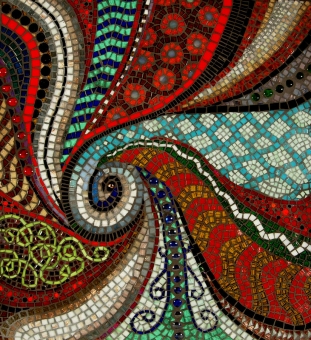Mosaic art history dates as far as 4,000 years or even more. Techniques were a lot simpler back then, the Sumerians used terracotta cones pushed into a background, but by the 8th century BC, pebble pavements appeared, made primary by black and white stone with unstructured patterns. In the 5th BC Greeks upgraded the technique and started using small 1 or 2 cm stones for more complex designs, filling the outlines with smaller black pebbles. In the 4th BC green ard red pebbles are used to recreate scenes of people and animals with higher geometrical precision.
The Greco-Roman mosaic contained various materials and techniques such as opus vermiculatus that used the tessarae. Cubes of 4 milliliters tessarae were cut and used to create emblemata, models that were inserted into walls for purely decorative purposes. The opus tesselatum technique involved marble, glass or stone. By 200 BC the tessarae was used to create complex patterns of historical scenes, animals, religion, gladiator fights, some even with three dimensional effects and movement illusion. Floors were made of pottery, stone and marbles to provide greater durability.
Precursors of the roman era, Christian, Byzantine and Islamic architecture integrated the mosaics. Christians basilicas were built in the late 4th century, decorated with wall and ceiling mosaics. Milan was the capital of the Western Roman Empire but in the in the 5th century Ravenna became the center of the late Roman mosaic art. The mosaic art history recognizes a great development of Christian mosaic in the the second half of the 6th century. Rome was also a mosaic center, but fell under the Byzantine art influence in the 7th -9th century with amazing pieces like the great dining hall of Pope Leo III and the mosaics of Santa Prassede, Santa Maria in Dominca and Santa Cecilia in Trastevere.
The Byzantine mosaic art blossomed between the 6th and 15th centuries, but most of the mosaics were destroyed in wars, like the Nea Church in Jerusalem and the Hagia Sophia in Constantinopol. Pieces of the mosaic floor of the Great Palace of Constantinopol survived, as well as some floral decoration in the Church of the Acheiropoietos , Thessaloniki. The most important surviving piece is the portrait of a man with a mustache.
Influenced by Romans and Early Christians, the Islamic architecture has a rich mosaic art history. Used to decorate palaces and religious buildings, the most important examples are the Umayyas Mosque in Damascus and Islamic mosaics produced in Moorish Spain. The central dome of the Great Mosque, Cordoba and the mihrab golden mosaics were made between 965 and 970 and have floral arabesques decorations and Arab calligraphy that describes the Great Mosque in Damascus.
Today, mosaics are a popular art and craft that anyone can do using stone, ceramics, glass, mirror, shells, and some even use more original items like photographs and doll parts.









































